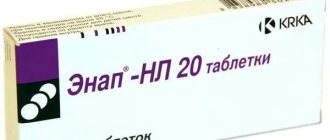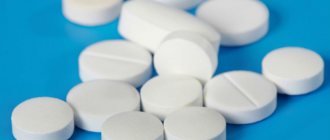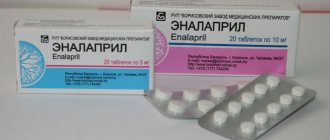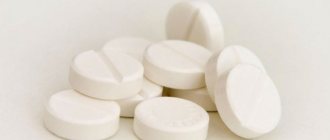Compound
One tablet contains the active ingredient enalapril maleate in an amount of 5, 10 or 20 mg.
Berlipril 5 tablets also contain additional components: lactose monohydrate, gelatin, magnesium carbonate, sodium carboxymethyl starch, silicon dioxide, magnesium stearate.
Berlipril 10 and Berlipril 20 tablets contain additional components: lactose monohydrate, gelatin, magnesium carbonate, sodium carboxymethyl starch, silicon dioxide, magnesium stearate, as well as a dye pigment in the form of iron oxide.
Pharmacodynamics and pharmacokinetics
The active substance is enalapril . The mechanism of action is aimed at inhibiting the angiotensin-converting enzyme and reducing the formation of angiotensin-2 from the precursor angiotensin-1 (causing a decrease in aldosterone secretion).
The drug reduces diastolic and systolic blood pressure, reduces preload and afterload on the myocardium. The drug acts more actively on arteries than on veins and does not cause a reflex increase in heart rate.
The most pronounced hypotensive effect is observed with a high level of renin in the blood. Berlipril has no effect on blood circulation in the brain; it increases renal and coronary blood flow.
With long-term therapy with enalapril, a decrease in the severity of left ventricular myocardial hypertrophy is recorded, the process of left ventricular dilation slows down, and the progression of heart failure .
In damaged myocardium, enalapril improves blood supply. The drug reduces platelet aggregation.
Berlipril helps to prolong life expectancy in patients with chronic heart failure. The drug has a mild diuretic effect.
Berlipril slows the progression of glomerulosclerosis and reduces intraglomerular hypertension. The main substance is a “prodrug” from which enalaprilat is formed through the process of hydrolysis. Enalaprilat inhibits angiotensin-converting enzyme.
When administered orally, the hypotensive effect is recorded within an hour. To achieve a stable effect, the drug must be taken for a long time.
Pharmacological properties of the drug Berlipril
Pharmacodynamics. Enalapril maleate is a salt of maleic acid and enalapril. Enalapril hydrolysis occurs in the liver, resulting in the formation of its active metabolite, enalaprilat, which is an ACE inhibitor. ACE converts angiotensin I into angiotensin II, a substance that has a vasoconstrictor effect. Inhibition of ACE leads to a decrease in the formation of angiotensin II in tissues and blood plasma, a decrease in the secretion of aldosterone and an increase in renin activity in the blood plasma. Since ACE breaks down bradykinin, which has a vasodilating effect, the consequence of ACE inhibition is an increase in the activity of the kalikrein-kinin system and, thus, activation of the prostaglandin system. The use of enalapril maleate in patients with hypertension (arterial hypertension) causes a decrease in blood pressure without a compensatory increase in heart rate and a decrease in peripheral vascular resistance. In patients with heart failure, the use of enalapril maleate leads to a decrease in peripheral vascular resistance, resulting in a decrease in afterload on the heart. When treated with enalapril maleate, there is an increase in IOC, an increase in stroke index and exercise tolerance, a decrease in left ventricular hypertrophy, and an improvement in intraglomerular renal blood flow. Enalapril maleate has no effect on the metabolism of glucose and lipoproteins. Pharmacokinetics. After oral administration, up to 60% of the dose is absorbed into the gastrointestinal tract. Concomitant food intake does not affect the absorption of enalaprilat. Bioavailability is about 50–70%. The maximum concentration in the blood plasma is reached after approximately 4 hours. The effective half-life of enalaprilat after repeated oral administration is 11 hours. Effective inhibition of ACE activity occurs 2-4 hours after taking a single dose of enalapril maleate. The onset of antihypertensive action is noted after 1 hour, and the maximum effect is observed 4-6 hours after taking the drug. The duration of action depends on the dose, however, when the drug is used in recommended doses, the antihypertensive and hemodynamic effects persist for at least 24 hours. In volunteers with normal renal function, steady-state concentrations are achieved approximately on the 3rd–4th day with a dosage of 10 mg every 24 hours. In the range therapeutic doses, binding to plasma proteins does not exceed 60%. Metabolites other than enalaprilat are not known. The drug is excreted primarily by the kidneys. Renal clearance is approximately 150 ml/min. The half-life of enalaprilat is 35 hours. The main component in the urine is enalaprilat (40% of the dose taken) and unchanged enalapril maleate (about 20%). If renal function is impaired, the release of enalaprilat decreases according to the degree of dysfunction. Enalaprilat is eliminated during hemodialysis and peritoneal dialysis. Hemodialysis reduces the plasma concentration of enalaprilat by approximately 46%.
Contraindications
Berlipril is not used during pregnancy, intolerance to ACE inhibitors, enalapril, or breastfeeding.
For idiopathic and hereditary forms of angioedema , for cerebrovascular diseases, for severe systemic, autoimmune connective tissue diseases, for cerebral circulatory failure, for aortic stenosis , coronary insufficiency, HMB, for scleroderma, systemic lupus erythematosus , for stenosis of the renal arteries, for the elderly age, diabetes mellitus , hyperkalemia, inhibition of bone marrow hematopoiesis, Berlipril is used with caution after consulting a doctor.
Contraindications to the use of the drug Berlipril
Hypersensitivity to enalapril maleate, to other ACE inhibitors or to any of the components of the drug. A history of angioedema, which developed as a result of the use of ACE inhibitors, as well as hereditary idiopathic angioedema (Quincke's edema, swelling of the face, lips, tongue, larynx and/or vocal cords). Narrowing of the renal arteries (bilateral or solitary kidney); condition after kidney transplant. Narrowing of the heart valve openings or the presence of other obstructions to the outflow of blood from the left ventricle. Primary increase in aldosterone levels in the blood. Primary liver disease or dysfunction. During pregnancy and breastfeeding. There is no experience using the drug in children.
Side effects
Cardiovascular system: orthostatic collapse , angina pectoris, chest pain, myocardial infarction, excessive drop in blood pressure, pulmonary embolism, palpitations, atrial fibrillation , atrial tachycardia , atrial bradycardia, arrhythmia.
Nervous system: anxiety, paresthesia, weakness, headaches, insomnia, dizziness, depression, drowsiness, confusion, fatigue, nervousness .
Sense organs: noise in the head, hearing impairment, vestibular apparatus disorders.
Digestive tract: jaundice, pancreatitis , stool disorders, dyspeptic disorders , loss of appetite, dry mouth, epigastric pain, nausea, liver disorders, bile excretion disorders, hepatitis.
Respiratory system: shortness of breath, bronchospasm, pharyngitis, rhinorrhea, interstitial pneumonitis , “dry” non-productive cough.
Allergic response: angioedema of the lips, face, tongue, skin rashes, dysphonia , laryngeal edema , epidermal toxic necrolysis, exudative, erythema multiforme, exfoliative dermatitis, vasculitis, serositis, photosensitivity, urticaria , glossitis , stomatitis , arthritis, arthralgia, myositis.
Urinary system: proteinuria , renal dysfunction.
Possible development of eosinophilia, libido disorders, agranulocytosis , eosinophilia, neutropenia, decreased hematocrit, hyperkalemia, alopecia.
Berlipril tablets, instructions for use (Method and dosage)
In accordance with the instructions for use, Berlipril is taken regardless of meals.
Monotherapy for arterial hypertension: initial dosage 5 mg per day. If there is no effect, the dose is increased by 5 mg after 1-2 weeks. After prescribing the drug, the patient is observed for two hours until blood pressure is completely stabilized. If well tolerated, the dosage is increased to 40 mg per day, the dose is divided into 2 doses.
The average daily dosage for moderate arterial hypertension is 10 mg. The maximum daily amount of the drug is 40 mg. Diuretic drugs are discontinued 2-3 days before Berlipril is prescribed.
For renovascular hypertension, the initial dosage is 2.5-5 mg per day.
In case of severe arterial hypertension, intravenous administration of enalaprilat under inpatient observation is permissible. For low systolic pressure, treatment begins with 1.25 mg.
Dosing of the drug is carried out over 2-4 weeks. If there is a severe drop in blood pressure, the dosage of the drug is reduced gradually.
Depending on the dose, it is convenient to use certain types of the drug: Berlipril 5, Berlipril 10, Berlipril 20.
Overdose of the drug Berlipril
There is only limited information regarding overdose in humans. The most likely sign of overdose is severe arterial hypotension, occurring approximately 6 hours after taking the tablets, and simultaneous blockade of the renin-angiotensin-aldosterone system with the development of a stuporous state. With an overdose of ACE inhibitors, circulatory failure, loss of electrolytes, renal failure, hyperventilation, tachycardia, increased heart rate, bradycardia, dizziness, fear and cough may develop. Treatment: IV infusion of sodium chloride solution is recommended. If there is a sharp decrease in blood pressure, the patient must be placed in a horizontal position with the lower limbs raised. Infusion of angiotensin II and/or catecholamines is advisable. If the tablets have been taken recently, the stomach should be rinsed and sorbents should be used. Enalaprilat is removed by dialysis. For resistant bradycardia, the use of an artificial pacemaker is indicated. It is necessary to constantly monitor the level of electrolytes and creatinine in the blood serum. Treatment of angioedema . The development of angioedema of the face, lips, tongue, larynx, and extremities can occur at any time during therapy. In these cases, the drug should be discontinued and the patient observed. If swelling on the face and lips is limited, the use of antihistamines is necessary. Swelling of the tongue, glottis and larynx can be life-threatening and requires emergency treatment, such as subcutaneous injection of 0.3–0.5 mg epinephrine (1:1000 dilution) and/or airway management .
Overdose
Manifested by stupor, convulsions, troboembolic complications , acute cerebrovascular accidents, myocardial infarction, and excessive drop in blood pressure.
It is urgent to place the patient in a horizontal position, with the head lowered below the level of the body. Gastric lavage and oral use of saline solution are effective; in severe cases, treatment measures should be aimed at stabilizing blood pressure through intravenous infusion of plasma substitutes and sodium chloride solution.
Enalaprilat is excreted during hemodialysis at a rate of 62 ml per minute. If necessary, angiotensin-2 is infused intravenously and hemodialysis is performed.
Interaction
Berdipril slows down the process of removing lithium from the body and increases the effects of ethanol.
The drug weakens the effect of medications that contain theophylline .
Other antihypertensive drugs, diuretics enhance, and estrogens and NSAIDs reduce the hypotensive effect.
When using potassium-sparing drugs and diuretics, the likelihood of hyperkalemia increases, which leads to agranulocytosis , neutropenia, and bone marrow suppression.
Cytostatics, allopurinol , immunosuppressants increase hematotoxicity.
Drug interactions Berlipril
Potassium-sparing diuretics and potassium supplements. Enalapril maleate reduces potassium loss caused by diuretics. Its simultaneous use with spironolactone, triamterene, amiloride, potassium preparations or potassium-containing salt substitutes can lead to a significant increase in serum potassium levels. Diuretics. The use of diuretics in high doses prior to the initiation of enalapril maleate therapy may lead to the development of hypotension. The hypotensive effect can be reduced by stopping the diuretic, compensating for the lack of fluid and/or salts in the body, or starting Berlipril therapy using a low dose. Other antihypertensive drugs . Combination use with antihypertensive drugs of other groups, nitroglycerin and/or other nitrates or vasodilators may enhance the antihypertensive effect of enalapril maleate. Lithium. The simultaneous use of enalapril maleate and lithium preparations is not recommended due to increased lithium levels in the blood serum. If this combination is necessary, serum lithium levels should be carefully monitored. Tricyclic antidepressants/neuroleptics/anesthetics and anesthetics. The antihypertensive effect of enalapril maleate may be enhanced. NSAIDs. When used in combination, the antihypertensive effect of enalapril maleate may be weakened. There may be a synergistic effect on serum potassium levels, leading to hyperkalemia and reversible deterioration of renal function. AKI may develop, especially in patients with signs of dehydration or in the elderly. Sympathomimetics. The antihypertensive effect of enalapril maleate may be weakened. Hypoglycemic agents. It is possible to enhance the effect of insulin and oral hypoglycemic drugs when used simultaneously with enalapril maleate, up to the development of hypoglycemia. This is especially possible in the first weeks of combination therapy, as well as in patients with impaired renal function. With simultaneous consumption of alcohol, the effect of enalapril maleate is enhanced. Acetylsalicylic acid/thrombolytic agents/β-adrenergic receptor blockers . There are no contraindications for the combination of enalapril maleate with these drugs.
special instructions
When treating patients with reduced blood volume (vomiting, diarrhea, hemodialysis, limited salt intake, diuretic therapy), caution must be exercised due to the risk of a sharp drop in blood pressure. Once blood pressure has stabilized, the diagnosis of transient hypotension is not a contraindication to enalapril therapy.
The risk of developing anaphylactic reactions increases when using dialysis, high-flow membranes. Correction of the dosage regimen is carried out depending on blood pressure indicators. Monitoring blood counts and protein levels in the urine is required.
Patients with cerebral vascular diseases, decompensated forms of CHF, and coronary artery disease require careful monitoring, since a sharp drop in pressure can cause renal stroke, myocardial infarction, and disturbances in the functioning of the renal system.
When you suddenly stop taking enalapril, withdrawal syndrome is not recorded.
Oliguria requires support for renal perfusion , stabilization of blood pressure, administration of vasoconstrictors and appropriate fluids.
For patients with pathologies of the renal system, it is recommended to increase the time between doses of the drug Berlipril and reduce the dosage.
Before conducting examinations of the functions of the parathyroid glands, the drug is discontinued.
In hot weather and intense physical activity, caution is required.
Before performing surgical treatment, it is imperative to warn the anesthesiologist and surgeon about taking enalapril.
The drug affects driving.
Berlipril® 10 (Berlipril® 10)
Symptomatic hypotension
Symptomatic hypotension is rarely observed in patients with uncomplicated hypertension. In patients with arterial hypertension taking Berlipril® 10, arterial hypotension develops more often against the background of dehydration, which occurs, for example, as a result of diuretic therapy, limiting the intake of table salt, in patients on dialysis, as well as in patients with diarrhea or vomiting. Symptomatic hypotension has been observed in patients with heart failure with or without renal failure. Hypotension most often develops in patients with more severe heart failure and associated use of high doses of loop diuretics, hyponatremia or impaired renal function. In these patients, the use of Berlipril® 10 should be started under medical supervision, which should also be careful when changing the dose of Berlipril® 10 and/or diuretic. Similarly, patients with coronary heart disease or cerebrovascular disease should be monitored, in whom an excessive decrease in blood pressure may lead to the development of myocardial infarction or stroke.
If arterial hypotension develops, the patient should be placed in a horizontal position and, if necessary, a 0.9% sodium chloride solution should be administered intravenously. Transient arterial hypotension when using the drug Berlipril®10 is not a contraindication to further use of the drug, which can be continued after replenishment of fluid volume and normalization of blood pressure.
In some patients with heart failure with normal or low blood pressure, Berlipril® 10 may cause an additional decrease in blood pressure. This reaction to taking the drug is expected and is not a reason to stop treatment. In cases where arterial hypotension becomes clinically significant, the dose should be reduced and/or discontinued use of the diuretic and/or Berlipril® 10.
Aortic or mitral stenosis/hypertrophic obstructive cardiomyopathy
As with all vasodilators, ACE inhibitors should be prescribed with caution to patients with left ventricular valvular stenosis and left ventricular outflow tract obstruction and should be avoided in cases of cardiogenic shock and hemodynamically significant obstruction.
Renal dysfunction
In cases of impaired renal function (creatinine clearance <80 ml/min), careful monitoring of potassium and creatinine levels in the blood plasma is necessary. In patients with impaired renal function, it may be necessary to reduce the dose of the drug and/or increase the intervals between doses. The development of renal failure has been reported when enalapril was prescribed, mainly in patients with severe heart failure or kidney disease, including renal artery stenosis. With timely diagnosis and appropriate treatment, renal failure during enalapril therapy is usually reversible.
In some patients initially without signs of renal pathology, an increase in the concentrations of urea and creatinine in the blood plasma was noted, especially with the simultaneous use of diuretics. A dose reduction of enalapril and/or discontinuation of the diuretic may be necessary. In this situation, it is necessary to exclude the presence of renal artery stenosis.
Renovascular hypertension
There is an increased risk of hypotension and renal failure when using ACE inhibitors in patients with bilateral renal artery stenosis or arterial stenosis of a solitary kidney. Even a small change in plasma creatinine may be a sign of decreased kidney function. The use of Berlipril® 10 in patients in this group should be started under close medical supervision, with low doses, the dose should be titrated carefully, and renal function should be monitored.
Kidney transplant
Since there is no experience with the use of Berlipril® 10 in patients who have recently undergone kidney transplantation, the use of Berlipril® 10 in patients in this category is not recommended.
Liver failure
In rare cases, the use of ACE inhibitors has been associated with the development of a syndrome starting with cholestatic jaundice or hepatitis and progressing to fulminant hepatic necrosis, sometimes fatal. The mechanism of this syndrome has not been studied. If jaundice appears or a significant increase in the activity of liver enzymes during the use of ACE inhibitors, the use of the drug should be discontinued, and the patient should be under appropriate medical supervision.
Hypersensitivity/Angioedema
There have been reports of angioedema (Quincke's edema) of the face, extremities, lips, tongue, vocal folds and/or larynx in patients taking ACE inhibitors, including the drug Berlipril®10, during different periods of treatment. In very rare cases, the development of intestinal edema has been reported. In such cases, treatment with Berlipril® 10 should be stopped immediately, and proper medical supervision should be carried out until the corresponding symptoms disappear completely.
Even in cases where only difficulty swallowing occurs without difficulty breathing, patients should be under medical supervision for a long time, since therapy with antihistamines and corticosteroids may not be sufficient. In very rare cases, angioedema of the larynx or tongue has been fatal. Swelling of the tongue, vocal folds and/or larynx can lead to airway obstruction (especially in patients who have undergone airway surgery), appropriate therapy including subcutaneous injection of 0.1% epinephrine solution (0.3-0.5 ml) and /or measures to ensure airway patency should be carried out as soon as possible.
In patients of the Negroid race, the incidence of angioedema when using ACE inhibitors is higher than in representatives of other races.
Patients with a history of angioedema not associated with the use of ACE inhibitors have an increased risk of its occurrence when using ACE inhibitors.
In rare cases, intestinal edema (angioedema of the intestine) develops during therapy with ACE inhibitors. In this case, patients experience abdominal pain as an isolated symptom or in combination with nausea and vomiting, in some cases without previous angioedema of the face and with normal levels of C1-esterase. Diagnosis is made using abdominal computed tomography, ultrasound, or surgery. Symptoms disappeared after stopping the ACE inhibitors. The possibility of developing intestinal edema must be taken into account when carrying out the differential diagnosis of abdominal pain in patients taking ACE inhibitors.
Anaphylactoid reactions during desensitization with an allergen from Hymenoptera venom
There are reports of rare development of life-threatening anaphylactoid reactions in patients receiving ACE inhibitors during the procedure of desensitization with hymenoptera venom (heminoptera). Such reactions can be avoided if the use of the ACE inhibitor is temporarily discontinued before desensitization begins. The use of ACE inhibitors should be avoided in patients receiving bee venom immunotherapy.
Anaphylactoid reactions during LDL apheresis
In rare cases, life-threatening anaphylactoid reactions have been observed in patients receiving ACE inhibitors during low-density lipoprotein (LDL) apheresis with dextran sulfate. If LDL apheresis is used, ACE inhibitors should be temporarily replaced with drugs from other pharmacotherapeutic groups for the treatment of arterial hypertension or heart failure.
Patients undergoing hemodialysis using high permeability membranes
in patients undergoing dialysis using high-permeability membranes (eg, AN69®) while receiving ACE inhibitors. Therefore, in this category of patients, it is recommended either to use a different type of dialysis membrane or to use antihypertensive drugs from other pharmacotherapeutic groups.
Neutropenia/agranulocytosis
Neutropenia, agranulocytosis, thrombocytopenia and anemia may develop during therapy with ACE inhibitors. With normal renal function and the absence of other complicating factors, neutropenia rarely occurs. Enalapril should be used with extreme caution in patients with collagen disease, those on immunosuppressive therapy, those taking allopurinol or procainamide, or a combination of these complicating factors, especially in the presence of impaired renal function. Some patients in this category developed serious infectious diseases, which in some cases did not respond to intensive antibiotic therapy. When using Berlipril® 10 in such patients, regular monitoring of the white blood cell count is recommended, and during treatment, all patients should be instructed to report to the doctor any signs of a possible infection.
Cough
Cough has been reported during treatment with ACE inhibitors. Usually the cough is non-productive and persistent and stops after discontinuation of the drug. The development of a dry cough due to therapy with ACE inhibitors should be taken into account in the differential diagnosis of cough.
Surgical interventions/General anesthesia
In patients undergoing surgery and/or general anesthesia with the use of blood pressure-lowering drugs, enalapril may block the formation of angiotensin II under the influence of compensatory renin release. If it is assumed that arterial hypotension develops by this mechanism, it can be corrected by increasing the volume of blood volume. Before surgical interventions (including dental procedures), it is necessary to warn the surgeon/anesthesiologist about the use of Berlipril® 10.
Diabetes
Patients with diabetes mellitus taking oral hypoglycemic agents and/or insulin concomitantly with Berlipril® 10 should be instructed to carefully monitor plasma glucose levels to detect hypoglycemia, especially during the first month of concomitant use with Berlipril® 10.
Hyperkalemia
In some patients taking ACE inhibitors, incl. enalapril, an increase in potassium levels in the blood plasma was observed. Risk factors for the development of hyperkalemia include: renal failure and deterioration of renal function, age over 70 years, diabetes mellitus, hypoaldosteronism, intercurrent diseases and conditions, including dehydration, acute cardiac decompensation, metabolic acidosis, simultaneous use of potassium-sparing diuretics (spironolactone, eplerenone , triamterene or amiloride), potassium-containing dietary supplements or potassium-containing table salt substitutes, or other drugs that increase plasma potassium levels (for example, heparin, co-trimoxazole (trimethoprim + sulfamethoxazole)), use of potassium-containing dietary supplements, potassium-sparing diuretics or potassium-containing diuretics substitutes for table salt, especially in patients with impaired renal function. Hyperkalemia can cause serious, sometimes fatal, heart rhythm problems. If necessary, simultaneous use of the drug Berlipril®10 and the drugs listed above should be exercised with caution. It is recommended to regularly monitor the potassium content in the blood plasma.
Lithium preparations
The simultaneous use of lithium and enalapril is not recommended (see section “Interaction with other drugs”).
Double blockade of the RAAS
There is evidence that the simultaneous use of ACE inhibitors with angiotensin II receptor antagonists or aliskiren increases the risk of arterial hypotension, hyperkalemia and renal dysfunction (including acute renal failure).
The simultaneous use of ACE inhibitors with drugs containing aliskiren is contraindicated in patients with diabetes mellitus and/or with moderate or severe renal failure (GFR less than 60 ml/min/1.73 m2 body surface area) and is not recommended in other patients.
Concomitant use of ACE inhibitors with angiotensin II receptor antagonists is contraindicated in patients with diabetic nephropathy and is not recommended in other patients.
In cases where the simultaneous use of two drugs acting on the RAAS is necessary, their use should be carried out under the supervision of a physician and with regular monitoring of renal function, blood pressure and electrolyte levels in the blood plasma.
Ethnic differences
Like other ACE inhibitors, enalapril may be less effective in lowering blood pressure in blacks compared to other races, possibly due to the higher prevalence of low-renin status in hypertensive patients in this population.
Use in elderly patients
Clinical studies of the efficacy and safety of enalapril were similar in older and younger patients with hypertension.
Alcohol
During the treatment period it is not recommended to drink alcoholic beverages. Alcohol enhances the antihypertensive effect of ACE inhibitors.
Galactose intolerance, lactase deficiency or glucose-galactose malabsorption syndrome
The drug Berlipril® 10 contains lactose, therefore its use in patients with hereditary galactose intolerance, lactase deficiency and glucose-galactose malabsorption syndrome is contraindicated.
Berlipril's analogs
Level 4 ATC code matches:
Dilaprel
Prenesa
Enap
Diroton
Lipril
Renipril
Parnavel
Fozinap
Tritace
Enam
Zokardis
Fosinopril
Lisinopril
Captopril
Monopril
Renitek
Hartil
Phosicard
Amprilan
Ramipril
Analogues include: Invoril , Renitek , Ednit , Enagexal , Enalapril , Enalozid , Enam , Enap .
Berlipril price, where to buy
The price of Berlipril 5 is 90 rubles per pack of 30 pieces.
Berlipril 10 costs 130 rubles for the same package.
The price of Berlipril 20 is approximately 190 rubles.
- Online pharmacies in RussiaRussia
- Online pharmacies in UkraineUkraine
- Online pharmacies in KazakhstanKazakhstan
ZdravCity
- Berlipril Plus tablets 25mg+10mg 30 pcs. Berlin-Chemie AG
RUB 348 order - Berlipril 10 tablets 10 mg 30 pcs.Berlin-Chemie
123 RUR order
- Berlipril 20 tablets 20 mg 30 pcs.Berlin-Chemie
RUB 176 order
- Berlipril 5 tablets 5 mg 30 pcs.Berlin-Chemie
70 rub. order
Pharmacy Dialogue
- Berlipril plus (tab. 25 mg + 10 mg No. 30) Berlin-Chemie AG/Menarini
RUR 347 order
- Berlipril 5 (5 mg tablet No. 30)Berlin-Chemie AG/Menarini
59 RUR order
- Berlipril 20 (tab. 20 mg No. 30)Berlin-Chemie AG/Menarini
160 rub. order
- Berlipril 10 (tab. 10 mg No. 30)Berlin-Chemie AG/Menarini
107 RUR order
show more
Pharmacy24
- Berlipril 20 mg No. 30 Menarini von Heyden GmbH/ Berlin Chemi AG (Menarini Group), Nimechchina/Nimechchina
90 UAH.order - Berlipril plus 10 mg/25 mg N30 tablets Berlin Chemi AG, Nimechchina
88 UAH order
- Berlipril 10 mg No. 30 tablets Menarini von Heyden GmbH/Berlin Chemi AG (Menarini Group), Nimecchina/Nimecchina
58 UAH order
- Berlipril 5 mg No. 30 tablets Menarini von Heyden GmbH/ Berlin Chemi AG (Menarini Group), Nimecchina/Nimecchina
39 UAH order
PaniPharmacy
- Berlipril plus tablets Berlipril Plus 10/25 tablets. N30 Germany, Berlin-Chemie
99 UAH order
- Berlipril tablets Berlipril tablets. 20 mg No. 30 Germany, Berlin-Chemie
92 UAH order
- Berlipril tablets Berlipril tablets. 5mg No. 30 Germany, Berlin-Chemie
45 UAH order
- Berlipril tablets Berlipril tablets. 10 mg No. 30 Germany, Berlin-Chemie
62 UAH.order
show more





